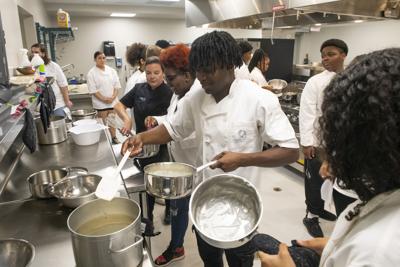Students are seeing the difference in the new kitchen for the Elmore County Technical Center culinary program.
The newly completed kitchen with two large gas ranges is serving as the new teaching lab for culinary instructor Perry Caton. Stanhope Elmore senior Destiny Pernell is seeing the difference. Pernell is taking Caton’s class for the second year in a row.
“It has been the same recipes as last year so far but it's better because we have a better kitchen,” Pernell said. “In the other kitchen we used basically hotplates. You couldn’t do things as well.”
Before the new kitchen at the tech center Caton was in a few different locations. She had limited access to gas ranges so she had to improvise, but the recipes were always finished on a gas range. The new kitchen means students get the full experience of a commercial kitchen from start to finish.
Last week students prepped for the range by slicing, dicing and chopping vegetables. Carrots, potatoes and onions were prepared for potato soup. Caton said all students participated in knife skills preparing onions in a variety of ways. Many were frozen for use in future recipes.
Around the ranges Caton assigned cooks and helpers.
“In restaurants and commercial kitchens the tasks are divided up,” Caton said. “We will rotate around and everyone will get to do everything.”
Caton sat back and watched as the students made the sauce for their potato soup.
“Basically they brown the butter and flour together and slowly add the milk,” Caton said. “If you just dump the milk, then you will be stirring forever until it thickens up.”
She said the kitchen is a lot of science.
“You follow a recipe but when you learn what happens, you realize it’s chemistry,” Caton said. “It’s things reacting.”
The smells of onions, cooking down and potatoes boiling in chicken broth tickled the noses of the students and Caton. She soon jumped into action asking Dequn Brown if he smelled something different.
“Did you notice the change in the smell?” Caton asked the students.
Caton said the sauce was at a point to be removed from the heat. She also pointed out how the sauce had thickened.
“This basic sauce is something we could add cheese to and make macaroni and cheese,” she said.
Brown picked up the pan and turned to go to a work table where other students had already gathered.
“Hot pan,” Brown said as he turned.
Caton said it is necessary to communicate in a commercial kitchen because people can get hurt due to burns and cuts.
Brown then added his sauce on top of a boil potato and vegetable mixture already in the pan.
The class is required for all of Caton’s students in the Hospitality and Tourism program and the Culinary Arts program at the tech center. It gives all the students an idea of what happens in the kitchen of a restaurant and also better prepares students who might work in a hotel that provides breakfast in the lobby.
“It is a skill they can use anywhere in the industry,” Caton said. “The culinary students will move on to bigger things in the kitchen but we have to start them all out.”
Some of the students will get certifications to help them in the restaurant industry. The certifications will help them get jobs at more than just fast food restaurants.
Caton said the class will split at the end of the semester into the two programs.
The class interested Stanhope Elmore High School sophomore Ashuntie Turner.
“I’m wanting to learn to cook more,” Turner said. “I want to cook at home.”
Like all the other students, Turner was wearing a white cooking jacket. At the end of the class Turner turned in her coat but not before all the students washed pots, pans and dishes.
It’s all about learning the different processes in the kitchen. Along the way a few mistakes are made but it is OK.
“We have a whole stack of pots that we have burned up,” Caton said. “It is fine because it is part of the learning process. You are going to mess up some, but this is the environment for it.”
Fried rice gets messed up too.
“Some just dumped everything in there,” Caton said. “They didn’t read the recipe, it doesn't work like that. It is a mushy mess if you don’t follow the steps.”
The students eat their creations and learn to serve in the lab’s dining room.
The skills also translate to home and students can follow the same recipe there too.
“We all got to eat,” Caton said. “Anybody can learn to cook if they have the patience or want to.”




